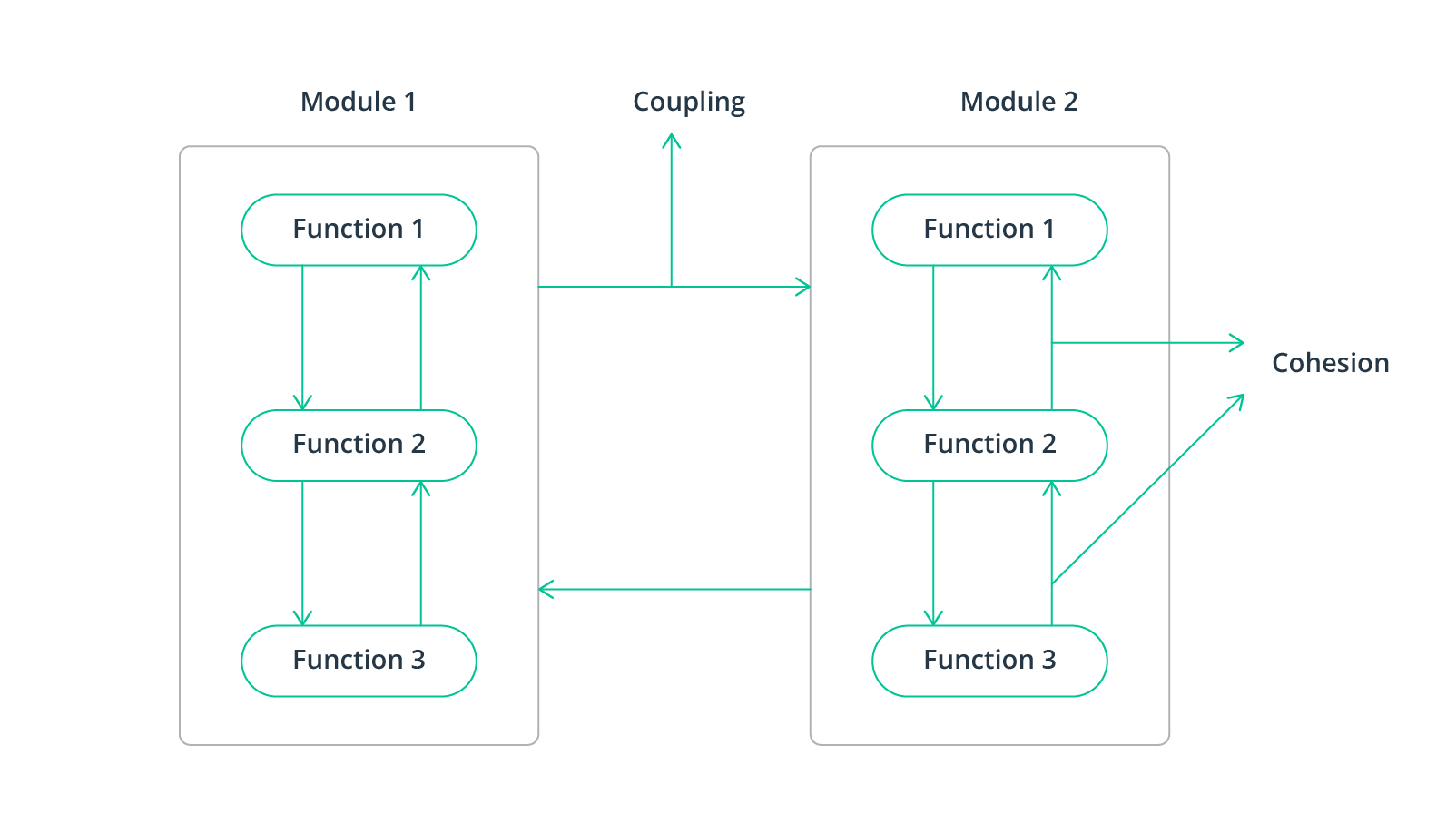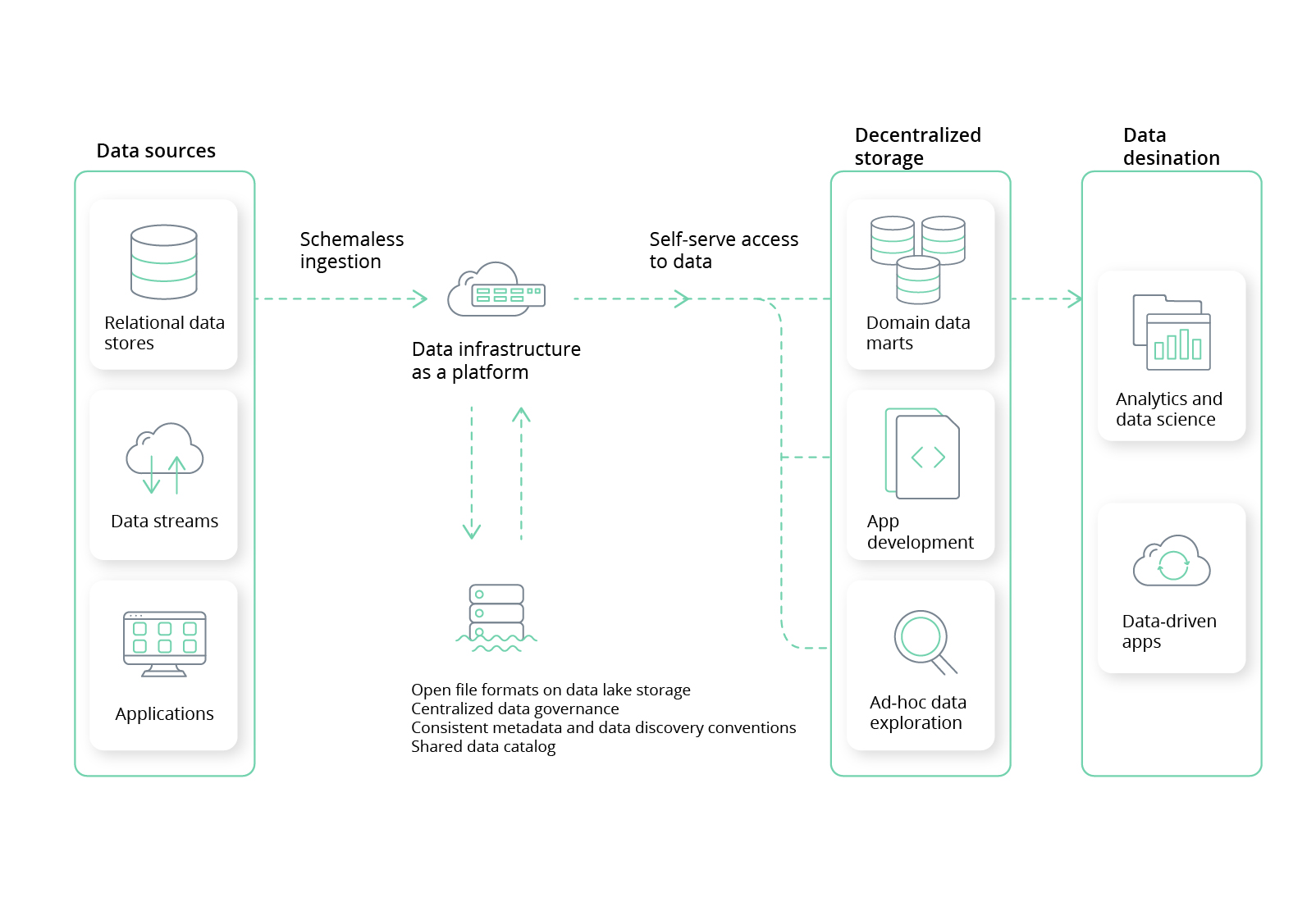Databases have significantly changed over the past decade: they migrated to the cloud, gaining extreme performance and complexity. They also evolved into data warehouses and data lakes, addressing the growing need for ultra-fast data aggregation and instant availability. Your typical data engineering strategy now requires different roles, including data engineers, data analysts and data scientists.
According to a recent report from Allied Market Research, there is a shortage of skilled data engineers, which can limit a business’s opportunities to leverage data. For this reason, our data engineers have stepped in and helped clients in various industries create al data engineering roadmap. For example, Intellias recently helped a national telecom provider migrate to the cloud for a more optimal solution. The client handled hundreds of terabytes of data in a legacy system, which created multiple inefficiencies and increased costs. Our qualified engineers helped the company reduce data processing time and CPU load, resulting in a more efficient system.
Read on to learn more about the required steps to build a data engineering strategy, the industry’s best practices, and how our engineers can help.
Importance of a Data Engineering Strategy
Experts estimate the global big data implementation and data engineering market to hit the $169.9 billion mark by 2029. The development of high-frequency trading platforms, predictive analytics, personalized recommendation engines, and many other intelligent systems requires the implementation of modern and efficient big data analytics systems.
It’s not just about cutting-edge solutions for large enterprises. Even midmarket businesses may be consuming vast amounts of data from external systems, field teams, sensor arrays, users, and more.

Source: ResearchGate
Companies grow and the number of sources and data types multiply. Processing these streams without delays and data loss becomes a great challenge. Thus, mitigating these issues requires you to come up with a detailed strategy for data engineering in big data.
Implementing modern data engineering principles in your strategy helps with:
- Enhanced data management. This ensures you avoid losing valuable insights and find all growth opportunities. Having the right specialists, tools, and infrastructure is critical to managing large data volumes effectively.
- Efficient data integration. This helps you prevent inconsistencies and maintain integrity across multiple sources. If your data is integrated correctly, you’ll easily extract meaningful insights and make data-driven decisions.
- Improved data warehousing. Traditional warehousing systems can’t handle modern volumes, so cloud solutions are better in terms of efficiency and scalability. As a Microsoft Gold Partner, Intellias can help you easily set up a reliable data warehouse.
- Better decision-making. It’s essential that businesses can extract data insights quickly and easily to grab all growth opportunities. Intellias helped a transportation company leverage this benefit to predict fleet behavior and forecast traffic, resulting in optimized costs.
Big data engineers use their in-depth knowledge, understanding of distributed and scalable cloud systems, and various specialized tools to create a data implementation strategy. They build high-performance data pipelines that consolidate data, transform it according to predefined rules, and then send it to designated storage destinations. That’s when the ball is in the court of analysts and scientists.
A big data engineer can use different technologies and tools depending on your business needs:

It’s important to understand that tools alone don’t get the job done. Ensuring an uninterrupted flow of data, its automatic conversion, and transformation requires a wide outlook on the business needs of the company and a thorough understanding of its infrastructure.
It also requires an ability to construct a flexible and scalable framework feeding perfectly structured, clean data outside. Additionally, it is typically assumed that data engineers are responsible for data security, integrity, and the overall support and maintenance of the pipeline.
All of the above, combined, makes the job of a data engineer a vital element of any company’s big data engineering strategy. This is demonstrated by a recent LinkedIn job market report, which placed Data Engineers as 8th on the list of the most popular emerging jobs.
10 Steps to Implement a Data Engineering Strategy
The experts at Intellias have created dozens of strategies for data engineering solutions across various sectors. Let’s check out how to build a data engineering strategy from scratch for your business.
1. Identify Challenges
Start building your data engineering strategy by identifying and understanding the challenges faced by your company. These can include different options depending on your project:
- Scalability: checking whether you can handle growing data volumes without performance loss;
- Integration: monitoring the consistency of your data from different sources;
- Quality: ensuring your data is accurate and reliable.
The experts at Intellias always begin their data engineering services by identifying challenges and conducting preliminary research. This is one of the data engineering best practices to reduce extra costs and optimize all processes.
You can also ask yourself the following questions to accelerate the transition to strategy execution:
- What data should you keep and delete?
- What platforms will you use?
- How will you structure the data: warehouse, lakes, or streams?
- Where will you store the data: cloud or local infrastructure?
- How will you cleanse and integrate the data?
Answering these questions will help you get a full understanding of how to implement a data engineering strategy in your company. You can also consider additional issues like backups, reviews, and anything else that can help during this process.
2. Choose the Right Tools
Choose the best tools and frameworks depending on your pipeline’s complexity and requirements:
- Off-the-shelf tools: workflow automation tools like Apache Airflow or Azkaban;
- Custom approaches: custom solutions with frameworks for more complex needs;
- Programming languages: Python for scripting and automation.
The right technologies are essential in your big data strategy. They help you launch the digital transformation process faster and understand all your needs during the early stages. This may also include the usage of large language models and data analytics.
3. Monitor Data Channels
You’ll have to develop methods to monitor data channels and capture incoming data. This requires you to consider several elements in your data operations:
- Data monitoring: implement tools like Prometheus and Grafana to track data flow and detect issues;
- Format handling: capture data in various formats from different sources using the ELK stack or Apache Kafka;
- Real-time capture: ensure data is captured in real-time with Prometheus or Datadog for timely processing.
Effective monitoring is essential for maintaining the integrity of your data pipeline. You can also use other tools depending on your expertise and needs, but these are some of the most popular choices.

4. Transform and Convert Data
Convert and transform data to match the format and schema of the target destination. You’ll have to use several data engineering techniques for this step:
- Data transformation: use ETL processes to transform data into the required format with tools like Apache NiFi, Apache Ray, Dask, or Talend and applying frameworks such as Apache Beam or Spark for processing large-scale data;
- Schema matching: ensure data conforms to the schema of the destination by using schema registry services like Confluent Schema Registry;
- Automation: automate transformation processes with scripting languages like Python or Scala and platforms like Apache Airflow and Perfect.
Proper transformation and conversion will help you integrate data seamlessly into your ETL pipeline. It will also ensure everything meets the required standards. You might want to integrate DataOps practices into your approach. We covered the importance of DataOps and its definition in our previous article. Check it out for a full understanding of big data in engineering.
5. Save to Target Destinations
Store the processed data in the target database, data warehouse, or data lake using efficient and reliable methods. Here’s what you can use with these options:
- Data warehouses: you’ll need platforms like Amazon Redshift, Google BigQuery, or Snowflake for structured data storage and fast querying;
- Data lakes: try out scalable cloud storage solutions such as Amazon S3 or Azure Data Lake for storing unstructured, raw data.
- Database management: get efficient database management with PostgreSQL or MySQL. Also, use tools like Apache Hudi or Delta Lake for data versioning and incremental updates.
- Data mesh or data fabric: solve complex data security through distributed and decentralized ownership.
You must also discern the differences between a data warehouse and a data lake to understand how they work. Some key points to remember:
Data warehouse: a centralized repository for structured data used for reporting and analysis.
- Schema-on-write: data is written according to predefined schemas using tools like ETL;
- Structured data: primarily used for fast access to historical data with platforms like Snowflake;
- Read-only mode: data remains in a read-only state for analysis, ensuring data integrity and performance.
Data lake: a place to keep unstructured, raw data in scalable cloud storage.
- Schema-on-read: data is read without predefined schemas using tools like Apache Hadoop;
- Flexibility: offers flexibility to users and systems accessing the data, suitable for various analytics tasks;
- Native format storage: data is stored in its original format, simplifying analysis with platforms like AWS Lake Formation.
Some companies also used data silos. We generally recommend avoiding data silos because they are difficult to integrate with all your other data. Intellias always suggests creating a centralized system that is accessible, actionable, and visible.
For example, our approach in retail data engineering with big data helped a company save millions of dollars in spoiled food stocks and reduce energy consumption by 20%.
6. Handle Schema Changes
Create mechanisms to handle changes in data schemas and business logic efficiently. Your data structures and their defined rules can change over time with new fields, types, names, and relationships. That’s why it’s necessary to handle these changes with such strategies:
- Schema modifications: tools like Avro or Protobuf a great for managing evolving schemas and ensuring backward compatibility;
- Business logic: data build tools can help you implement changes in business logic with transformation adjustments and validation rules;
- Automation: use data engineering automation of schema updates and validation processes with CI/CD pipelines using tools like Jenkins or GitLab CI.
This will help you get additional flexibility and maintain data accuracy. Also, automating schema changes minimizes downtime and ensures that data pipelines continue to function smoothly, even as underlying data structures evolve.
7. Maintain and Optimize
Regularly maintain and optimize your data pipeline for performance and reliability to ensure smooth and efficient operations. The best practices in data engineering require you to consider the following:
- Pipeline maintenance: regular checks and updates using tools like Apache Airflow to automate maintenance tasks and ensure that all components of the pipeline are functioning correctly;
- Performance optimization: use performance monitoring tools such as New Relic or Grafana to identify bottlenecks and potential spots for improvement;
- Error handling: implement error detection and correction mechanisms with logging frameworks like Logstash to capture and analyze error logs. Also, set up automated alerts to notify your team in real time and establish clear error-resolving workflows;
- Scalability: ensure your pipeline can scale according to your increasing data volumes and complexity. AWS and Azure are great cloud solutions for elastic storage.
Timely maintenance and optimization are necessary to prevent bottlenecks and let your data flow without obstacles. This will help your company get all insights on time with no delays.
9. Balance Costs and Resources
Your budget isn’t eternal, so you’ll have to manage all the costs effectively. Follow these points to minimize expenses and get the most value in return:
- Cost management: balance spending on storage and compute resources with cloud platforms like AWS and Azure;
- Scalable Solutions: use scalable cloud storage for cost-effective data management, ensuring you only pay for what you use;
- Resource allocation: optimize resource allocation using tools like Kubernetes for dynamic resource management.
There are many places to save your budget from extra costs. However, it takes experience and expertise to define these spots and maintain maximum value. For example, Intellias helped Germany’s first fully digital bank set up a cost-efficient and effective data lake platform. Our platform development experts will help you get all the best solutions for your project.
10. Partner with Professionals
You’ll need a reliable team of data engineers with expertise in your product’s industry. This will ensure they follow all these steps and help your business get a reliable solution that brings valuable results. Intellias has been in the market for 20+ years, and our expertise spans cloud-native architectures for rapid deployment and management of next-generation data infrastructures, ensuring operational efficiency and cost savings while minimizing errors through transparent, AI-driven decision-making processes.
Best Practices of Big Data Engineering
Following the industry’s data engineering best practices is key to creating high-quality data solutions in any company. We gathered the most valuable practices based on the experience of our engineers.
1. Modular Approach
Modularity involves designing data systems as discrete modules, each addressing specific problems. This approach simplifies code readability, reusability, and testing. Modular systems are easier to maintain and allow new team members to quickly understand and contribute to the project. Segregate datasets into modules based on their use or category to enhance data management.

Source: GeeksForGeeks
2. Pipeline Automation
Automating data pipelines increases productivity and ensures consistency in data processing. Automated pipelines handle data extraction, transformation, and loading without manual intervention, saving time and reducing errors. Use tools like Apache Airflow or Luigi to set up reliable and efficient automated pipelines. The modern practice is to use AI to get rid of most routine tasks in data engineering.

Source: Estuary.dev
3. Maintain Repeatability
Design data patterns that address repetitive issues efficiently. You can speed up data processing and improve development productivity by creating reusable solutions for common issues. Identify repeatable issues and build standard processes to handle them effectively.

Source: Upsolver
4. Security Policy for Database Management
Implement robust security policies to protect data from potential threats. Track all data-related actions and set rules for secure data access. Categorize data sensitivity issues and define solutions to mitigate risks. Create comprehensive documentation to ensure data safety and guide new team members.

Source: Venture in Security
5. Maintain Proper Documentation
Keep detailed records of all aspects of data management from sourcing to processing. Proper documentation helps everyone on the project understand the data pipelines and security policies inside out. This practice ensures continuity and facilitates smooth transitions for new team members.
6. Apply DataOps
DataOps is a collection of data practices designed to promote collaboration and efficiency in data analysis. It deals with the entire data lifecycle, from data gathering to successful analysis. DataOps combines different tools and methods to analyze data well. It is used a lot in Azure data engineering best practices.

Intellias provides DataOps services that help companies get transparency and structure in their data flows. You’ll get a new meaning in your data analytics with our team’s expertise.
The Intellias Experience
With expertise in designing data engineering strategies, Intellias excels in crafting scalable end-to-end data processing solutions that extract meaningful insights from diverse data sources, regardless of size or complexity. By consolidating data silos and building future-ready platforms, we enable data-driven decision-making that accelerates market insights, enhances competitive advantage, and drives revenue growth.
Here are our leading data engineering examples and case studies:
Data strategy guidance for a global construction brand.
- We collaborated with a client to streamline and optimize their data governance using Azure and Power BI. This project is ongoing, with continuous support to enhance data alignment and transparency for the brand.
Digital retail consulting to orchestrate data flows and operations.
- We partnered with a global food retailer to provide consulting services and improve the company’s data platform. This project resulted in a long-term partnership with many other projects emerging from it.
A platform for equipment monitoring in supply chains.
- We developed a real-time big data analytics and temperature monitoring platform for a network of 125 stores in the Baltic States. This reduced energy consumption by 20% and saved the company millions of dollars.
Conclusion
Data engineering, a vital element of any tech strategy, is helping businesses make data-driven decisions, provide better services, and react to market demandApplying best practices to data engineering best practices allows you to get maximum value for your data insights and reduce extra costs.
Intellias is your reliable partner in all data-related activities. Our large talent pool of engineers will help you create a powerful data pipeline and extract insights that will help your company grow. Contact our team today to get a consultation and launch your project.


